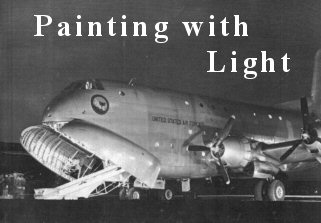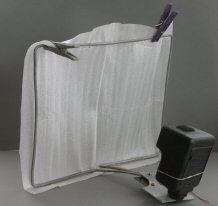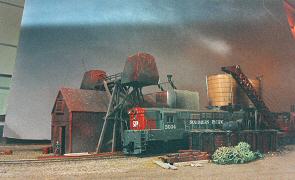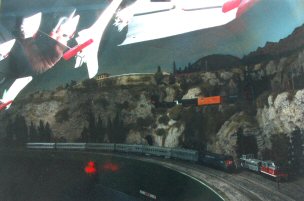
I think you can tell how many flashes were used to light the nose by the reflections on the door. There was only light coming from inside the plane which burnt out the gangway.
About sixty years ago about the time that flashbulbs were giving way to electronic flash night fell before my boss and I could get the mandatory shot of this plane. First time the USAF had flown one into the country.
Having been introduced to Painting with Light by the John Alton book of that name, I suggested to the boss that we leave our shutters open and walk around firing the flashgun. Boss had a Rolleiflex with which he had started that phase of press work and a light tripod. It was windy and I laid my Speed Graphic on the ground, hence the flat tires from curvature of the runway, and got a nice steady shot.
That was before flashguns got clever and had photo-cells to measure the light coming back from the subject. A flashgun has a guidenumber and one simply divides it by the flash-to-subject distance to get the aperture.
Else in this case you decide on an aperture to use and fire off a number of flashes to get the exposure for the area of the subject you are lighting.
For 100ISO film 56 [metric 17 using metres to measure distance] is a common guide number. At 10ft you use f/5.6, at 15ft f/4 or two flashes if you left the camera set at f/5.6 etc etc.
I have read about people using flashlights [torches] to do this sort of thing but I would suggest that a torch gives off a very reddish light, as far as film is concerned. Not so bad for Type B film designed for a Colour Temperature of 3200K but way off for daylight film.
Also seen a shot of the inside of a theatre where the guy walked around with a photo-bulb on a long power cord. This has the same result as with a torch of giving a continuous and soft light over the subject against the flash which gives a sharp light. One could organise a diffusion screen in front of the flash to get a soft lighting result.

Not sure if this photo is painting with light -> but was used to get a multi-light set-up of a static subject. The flash had a diffusion screen on a wire frame attached to it.
To get a 2:1 ratio of Key light to Fill light on the other side of the camera the flash was twice fired from the Key position. With single flash from fill and at the background area.
One problem with a diffusion screen away from the flash is that if you tilt it too far some light could spill over the top as here.

Another problem is getting in the picture! L

At the end of the session and tired.